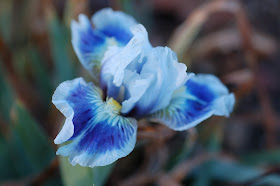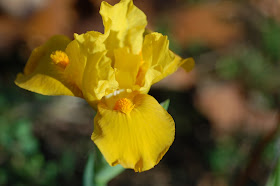Kathleen Sayce
January 27, 2018
For a change of pace, I’ve been making iris leaf cordage, using a simple three strand twist of dead Iris douglasiana leaves. Using fine thin leaves, this works up quickly into cord. The leaves are individually twisted counterclockwise and then wrapped clockwise around the other two twists. These cords are twisted together or braided to make stronger ropes. This method is widespread in Europe and North America as a way to make cords from many plant species, including nettles, milkweed, flax and other plants.
 |
A few feet of Pacifica Iris leaf cordage, made in an hour from brown leaves
from Iris douglasiana. Note the lumpy area on the right where I twisted in a
larger leaf. Next time, I'll split the leaves into uniform widths first. |
Harvesting Pacifica Iris leaves when they have just turned brown probably gives a stronger cord. I went out this winter between rain squalls to get dead leaves, and quickly focused on thin, still-strong leaves of Iris douglasiana selections like Iris ‘Mission Santa Cruz’. I have several larger leaved selections, so could make larger cords from those leaves.
Something to remember for next fall —harvest iris leaves at the right time, between loss of green in fall and subsequent decay in late winter. Clean and dry, the leaves can be stored for months, then soaked in water to prepare to twist.
 |
Iris douglasiana leaves before twisting into cordage. They were already damp,
so did not need a presoaking in water to soften before using. |
West Coast tribes in northern California made rope from Pacifica Iris leaf fibers. Leaves were harvested from late summer into fall, wilted, then split and scraped to remove a strong fiber, one from each side of the leaf. Fibers were rolled and twisted into fine cord, then multiple cords were twisted together to make strong light ropes. Strong lines to trap deer and elk were made from those ropes. The processing that went into removing and cleaning the fibers, then twisting into cordage, then wrapping cords to make rope, and making nets from the rope, was considerable. Read more about this method here: http://www.paleotechnics.com/Articles/Irisarticle.html .
Irises, including all Pacifica Iris, have the same strong fibers in their leaves. Years ago the general iris leaf structure of two outer layers of leaf linked by fibrous cross walls was compared to a I-beam--creating a strong, flexible leaf. The authors looked at dozens of species in many iris sections, and while the cross-beams changed a bit in shape, the basic plan did not, across all species they examined. If you have access to a college library, look for "Structure and mechanics of the iris leaf", Journal of Materials Science, vol 23, pages 3041-3048, by L. J. Gibson, M.F. Ashby and K.E. Easterling, published in 1988.
Iris douglaisana, I. macrosiphon, I. purdyi and natural hybrids of these species seem to contain the right vein structure in their leaves, with two larger veins running up the outside edges. I suspect this is because they tend to have larger leaves.
 |
| The thin end, made from fine leaves. |
During dry moments this winter, I also collected long green leaves from several Pacifica Iris plants to see if there are usable fibers in them. It’s a little late in the year, but on the West Coast, this winter has been mild and wet, and iris leaves are still green. As with other fiber-containing species, longer iris leaves produce longer fibers, which spin more easily into cordage. Now I wonder what the leaf fibers are like in Iris unguicularis, I. lazica, ornamental Carex, milkweed, and Diplorrhena.
 |
A closeup of the three-leaf cord, showing natural color variation
in brown Pacifica Iris leaves. |
It’s a slippery slope from playing with natural cordage to spinning your own yarn, I understand, and I’m hoping to not be enticed into another hobby just yet. My goal is to garden as long as I can, and only then retire to less taxing hobbies.




































